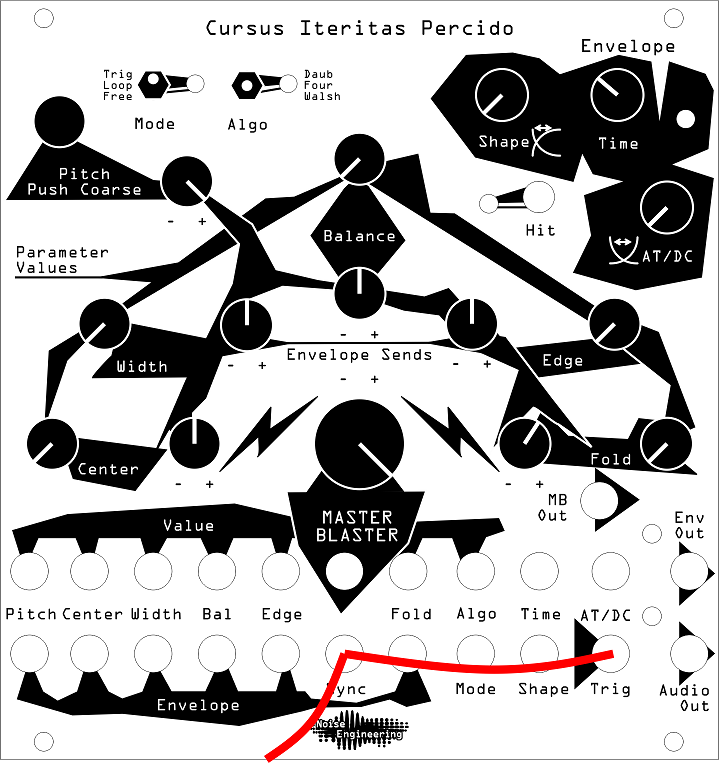Kick out the jams: synthsizing some kicks (for jams)
Markus back again with a new series!
Percussion is fun. However, in Eurorack, drum sounds often come prepackaged in dedicated modules or prerecorded as samples, without much room for creativity. What about patching them up ourselves? In this series, we’re going to talk about the fundamentals of percussion synthesis and how to patch some great percussion sounds with modules you may already have in your system. This week, we’ll start with…
Kicks
Kicks are the backbone of many genres of electronic music. From dance to industrial, a driving kick drum moves a track and sets a groove. So it should sound good. But where do we start?
Kicking it oldschool
Most of the concepts we’ll talk about today date back to the 80’s, when Roland introduced a couple of very famous and influential drum machines. The circuitry in the 808 and 909 was interesting in that it was relatively simple but did a lot (and sounded great). Because of that simplicity we can patch similar sounds and concepts in our modular system.
Why no BIA? What is this blasphemy?
We make a module you may have heard of called the Basimilus Iteritas Alter. It’s a complete synthesizer voice based around creating percussive sounds.
Because of this, I’m not going to be using the BIA in this post, because, let’s be real, that’s cheating! Of course, if you want great sounding percussion out-of-the-box, BIA is your best friend. I have two in my system and I use them all the time. But we’re not talking about those today.
Kick back and relax
Let’s start simple. The most basic kick drum you can patch basically consists of a sine wave with an envelope on its pitch and a VCA and envelope controlling its amplitude. This can be created with separate modules, of course, but voice modules like the Cursus Iteritas Percido and Loquelic Iteritas Percido can be great all-in-one percussion solutions as well.
CIP is one of my personal favorites for kicks: with Master Blaster you can set up a simple and easily performable kick patch. This is great for live use, making samples, and as a fun studio tool.
Here’s a simple kick I’ve made with CIP: I’ve tuned it down so the fundamental (lowest) frequency in the sound is sitting in the bass range where I want it. The Pitch envelope is fully up, there’s a little bit of Fold envelope to give it a harder edge, and I have a snappy, relatively short envelope to keep it percussive.
I’ve also used a useful technique here: I multed my trigger to the Trig in as well as the Sync input. Triggering the Sync in resets the waveform, keeping our kicks sounding the same (the waveform is always in the same position) and clicky.
Here’s the patch, the red lines are my trigger:
And here’s what it sounds like:

Cool! But what about something a bit more interesting?
Let’s kick it up a notch
Aren’t you glad we’re almost done with the kick puns? No, of course you’re not.
For this patch, we’re going to get a bit more complicated. A common technique in analog drum machines is to have a pulse generator (basically a trigger) mixed into the audio path of a percussive sound. It was an easy way of adding a punchy transient to a sound. Here, we’ll use a similar concept. It’s also helpful to give a kick a short, high-frequency element to help it cut through a mix. We’ll do that too. As you can probably guess, this will be a more complex patch than our previous one.
We’ll be using a few modules: LIP, Sinc Bucina, Sinc Iter as a noise oscillator, and our lunchbox mixer, Xerest Pola, though any mixer will do.

Obviously, this is a much more complicated patch, so let’s break it down.
First, the trigger (indicated by the two red dots) is multed and activates our envelopes. On the SB side, SI (in Noise Mode) gives us some Perlin noise to create a short noise burst. SB is in VCA mode so it’s not doing any filtering, and its envelope is extremely short, so this is barely even heard; it’s just a little bit extra for the initial transient of the kick.
Next, the LIP: the body of the kick is similar to what we did with the CIP earlier in this post. The pitch envelope modulating the sine wave creates the main kick sound, with a little bit extra of extra body from some wavefolding. You may notice something weird here, though: we’ve sent the Envelope output to our audio mixer: this is similar to the technique we talked about earlier. Instead of using a pulse generator, we’re using a click created by our snappy envelope as an actual audio signal. It creates a big difference in how impactful the sound is, and this is actually what makes a lot of analog kicks sound so good.
It’s all then mixed up in XP and sent out to the rest of our patch. Here’s what it sounds like:
In kicklusion
Last one!
There’s a lot that can be done with kicks. And, remember, while we used a lot of voice modules in this post, all of this can be done with multiple modules as well: anywhere you see a voice here, it’s just an envelope, an oscillator, and a VCA. Patch it up with the modules you have in your system, and if you come up with something cool, share it with us on our Instagram page!





